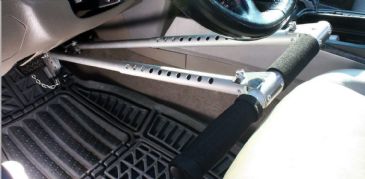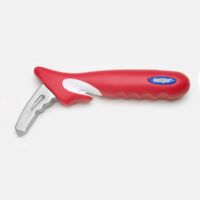 Written by Brittany Ferri, OTR/L
Written by Brittany Ferri, OTR/L
Driving is considered an important contributing factor to someone’s sense of independence and freedom. But, unfortunately, driving can be very difficult for some individuals with disabilities. Anyone can experience issues such as fatigue and pain that impact safety while driving, but there are a range of other physical symptoms and disabilities that get in the way of basic driving functions.
According to the U.S. Department of Transportation, people between 18 and 64 years old with disabilities only drive 60% of the time when they need to leave their homes. Part of the reason this statistic is so low is that many people do not know about the variety of assistive devices that can help someone operate a vehicle. Hand controls for cars are among some of the most common adaptations with a range of options for drivers with disabilities.
The good news is that, many times, Medicare and other insurance companies will reimburse for hand controls if they are medically necessary. This means that, once you speak with a healthcare professional to determine the hand controls that are best for you and your vehicle, you can get one at little to no cost to you. In order to determine the best type of hand controls, you need to first know what hand controls are and which ones can benefit you.
Hand controls for cars are assistive devices that allow someone to operate a car’s functions in a nontraditional way. Hand controls can be used for functions such as the gas pedal, brake pedal, cruise control, turn signals, and much more. For example, a hand control might be useful for someone who has fine motor concerns that prevent them from using one finger to press a temperature control button. This modification might consist of tapping a large paddle with their entire hand instead, since this does not require someone to have as much motor control as a small button does.
Various types of hand controls cater to people with certain limitations. Since people with the same health concern can present with different symptoms, it’s possible for two individuals with spinal cord injuries, for example, to use different hand controls in their vehicle. These modifications are intended to help someone overcome certain symptoms and the long-term effects of disability. Below, we will talk about some of the most common hand controls and who they might be useful for.
 | Universal Crossover Signal Adapter for Cars View Product |
 | Drop-Down Turn Signal Arm Extension View Product |
Individuals who have difficulty reaching next to the steering wheel to access a traditional turn signal would benefit from this turn signal adapter. Some people might have difficulty grasping the small cylindrical turn signal effectively enough to operate it. In other cases, individuals might struggle with the speed of movement needed to remove one hand from the steering wheel to activate the turn signal. Depending on the car this is being used on and the physical needs of the driver, a turn signal adapter might bring the lever from the left or the right side of the steering wheel to be positioned above the steering wheel for easier viewing and access. Another option is a drop-down function that positions the button just behind the bottom of the steering wheel so the driver only needs to move one finger to trigger it.
These options are much longer than other hand controls, meaning they offer increased ease of access for the driver. Someone with cerebral palsy, arthritis, visual neglect, or a spinal cord injury might benefit from a turn signal adapter.
If a driver is having difficulty accessing the turn signal, which requires them to flick it up or down, it is likely they are also having trouble making small adjustments to that device. These adjustments are made by manipulating small wheels on the turn signal that control settings such as cruise control, headlights, and windshield wipers. These wheels require a driver to use two fingers to grasp a one-inch wheel and make small rotations to click between various settings. Such small motions will be difficult for individuals with severe arthritis, carpal tunnel syndrome, spinal cord injuries, residual weakness from a stroke, and even a more isolated injury that has impacted the hand, such as a finger fracture or tendon repair.
Control extensions are larger, notched wheels placed directly around the default wheels, which makes it easier to operate them. These notches enable someone to use several fingers to turn it according to what they need. The style of the adapted wheel also makes it so someone can operate the controls without even bending their finger, meaning it’s a great option for someone who has difficulty bending and grasping with one or more fingers.

Drivers with foot and leg problems that are exclusive to the right side of the body would benefit from a left-foot accelerator to help them operate the gas pedal. Someone might struggle with using a traditional accelerator pedal if they have foot drop, neuromas, one-sided weakness due to a stroke, cerebral palsy, or a low-level spinal cord injury that only impacts sensation and/or movement in the right leg.
Most left-foot accelerators are removable and can be placed in nearly any car since they require little to no installation. They offer a larger base that has both a gas and brake pedal where someone can place their left foot. From here, they can flex and extend their ankle to operate the gas in conjunction with the brake just as they would with regular pedals.
 | Freedom Staff Driving Hand Control - Thumb-Activated View Product |
 | Freedom Staff Driving Hand Control - Grab Bar View Product |
When most people think of hand controls, they imagine mechanical hand controls. These consist of a long bar with a small button on the end. The flat end is positioned on the gas pedal and the button is propped up against the seat next to the driver’s leg. This allows them to operate the gas pedal without using their feet at all.
Someone using a mechanical hand control should have full function of their right hand to be able to grasp the bar and use their thumb to trigger the button. These hand controls are ideal for people with foot drop, a temporary foot injury such as a fracture or tendon injury, a spinal cord injury, and one-sided leg and foot weakness secondary to a stroke.
 | Climate Control Extensions for Toyota Sienna, with 8-in. Extension Rods, Helps to Reach Controls, Easy to Install, Tethered Stylus, by Johnson Hand Controls View Product |
Since there are hand controls for nearly every function in the car, it makes sense that there are also accessory extensions. These are typically custom-made devices that fit right over the controls, buttons, and knobs that operate climate control, the radio, display settings, and more. Drivers who might benefit from accessory extensions include those with arthritis, visual neglect, arthrogryposis, short limbs, a spinal cord injury, and one-sided weakness resulting from a stroke.
The custom nature of these devices is simply because they vary based on the type of car someone is driving. For example, the Chrysler Pacifica Shift Knob Extension Set will not be suitable for someone who is driving a Toyota. While someone driving a Toyota Sienna will need to use Climate Control Extensions for the Toyota Sienna. This nuance is specific to accessory extensions and not many other features of cars. For example, there isn’t any variation in the location and style of the gas pedal in different cars, which is why a device such as a mechanical hand control will be the same across the board. Accessory extensions do not have a one-size-fits-all option, BUT the good news is that we have a vendor, Johnson Hand Controls, who customizes these devices based on the make and model of our customer’s cars. If you are interested, call RehabMart directly to learn more about this option and get the ordering process started!
 | Universal Steering Wheel Spinner Knob View Product |
Individuals with concerns related to upper extremity motion would benefit from a steering wheel spinner knob. This is best for drivers who struggle with impaired shoulder, elbow, and wrist movement on one or both sides. These body parts should be working properly in order to allow someone to place pressure on and turn a steering wheel. A steering wheel spinner knob is a good fit for individuals who are pre- or post-shoulder replacement, or individuals who have one-sided weakness due to a stroke. The knob does still require someone to use their fingers and hand effectively to grasp and turn the knob, so this is an important consideration.
A spinner knob can be easily mounted on the top of the steering wheel for someone to turn just as they would the wheel itself. However, instead of using their full arms to maneuver the whole wheel, they just spin the smaller knob to serve the same function.
 | HandyBar Support for Vehicle Entry and Exit View Product |
For some individuals with disabilities, one of the most difficult parts of being a driver or passenger is getting in and out of the car. This is also a concern for older adults (with or without disabilities). Studies show that each year around 37,000 people over the age of 65 are injured when getting in and out of a vehicle.
This act can be strenuous due to limited hip motion, poor strength, impaired balance, and an unbalanced center of gravity. A car door assist handle is a great way for anyone with these concerns to get in and out of the car more safely and efficiently. This simple tool latches into a hook found in the door jamb of most vehicles. Since the only other handles available are inside the car, this centrally-located bar-style handle offers the right amount of assistance to someone located inside or outside of the vehicle.
 | Grab-N-Pull Seat Belt Reacher View Product |
Individuals with limited shoulder motion might struggle to engage one of the most important safety features of a vehicle: the seat belt. A shoulder injury of any kind makes it difficult to reach across and behind the body to pull the seat belt forward and lock it into place. This is why a simple device such as a seat belt reacher can be so useful. Someone with arthritis, shoulder replacement, neurological conditions that prevent someone from crossing midline, visual neglect, and more can benefit from a seat belt reacher. This device hooks onto the seat belt and has a handle that can be pulled forward and across without exerting as much effort.
A: Usually, yes. If you keep your proof of purchase, you should be able to deduct the purchase of hand controls if they are intended to assist you with managing a disability. Learn more about this by reading Tax Deductions for Durable Medical Equipment and speak with a tax professional.
A: Depending on the type of device, hand controls can cost between $50 and $12,000. Smaller, low-tech devices such as steering wheel knobs can cost on the lower end of that spectrum. Digital, large, and/or custom-made devices can cost several thousand dollars.
A: If certain vehicle modifications are considered medically necessary, the VA will help pay (and, in some cases install) equipment such as hand controls on a vehicle. Reach out to your nearest VA for more information.
A: Most hand controls are designed to universally fit all makes and models of cars. However, if a device doesn’t fit your vehicle for some reason, it can be custom-made to the specifications of your car. RehabMart has a vendor, Johnson Hand Controls, that is willing to create custom car controls! Email quotes@rehabmart.com with your request, and include the year/make/model of your car.
A: In the case of hand controls that help with major functions such as the use of a gas pedal, it can take up to two weeks to fully get used to the new device. However, most smaller devices can be used very easily within a day or two of installation. These are usual timeframes, but keep in mind that everyone’s learning style and disabilities are different.
A: RehabMart is a great source of a range of handicapped driving controls for sale to assist with a range of disability-related impairments.
A: As long as the hand controls meet the criteria for durable medical equipment, Medicare Part B will often reimburse for the cost of these devices. Read more at Does Medicare Cover Vehicle Modifications?, and speak with your insurance provider for more information, as RehabMart can't guarentee what your insurance will cover.
There are a range of hand controls to help individuals with disabilities modify their vehicles for easier and safer use. Each person will benefit from different hand controls based on their specific impairment. For example, someone who had an isolated injury to their right foot would benefit from a mechanical hand control to assist with using the accelerator while someone with severe arthritis would be better served by control extensions. If you need help choosing the right-hand controls, speak to your healthcare provider to get specific recommendations.
Thank you for reading our article on hand controls for drivers with disabilities! We discussed just a few hand control options, so you might like to take a look at our entire selection of car helpers for sale. If you want to learn more about assistive devices, visit Caregiver University for additional rehabilitation-related articles.

Brittany is an occupational therapist who has worked in a variety of rehab facilities. She has always expressed an interest in patients’ internal motivation for therapy and the use of assistive devices, which led her to pursue a PhD in Integrative Mental Health. This research-based training has also led her to develop her writing career to educate patients of all ages on how to improve their health. Brittany has published four books, written over 300 articles, and has been quoted in media outlets such as WebMD, Healthline, and NBC News.